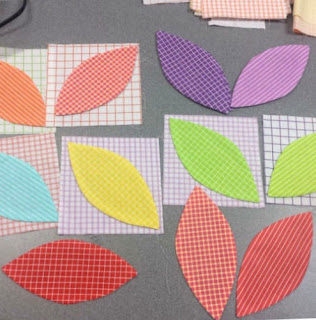You're probably expecting me to wax poetic about the loveliness of completely making a quilt from start to finish, right?
Nope. There's one MAJOR reason I have never sent a quilt out in 6.5 years, and probably never will. Not even show quilts.
It's cheaper to quilt it myself, on my home machine!
I
typically free motion quilting, but sometimes I straight line quilt
with my walking foot. Here's my work in progress this week - I've marked
lines with my chalk pencils. And this quilt is based on a beer bottle... more soon!
When I first started making quilts, I was in the middle of earning my undergraduate degree in history and teaching. I had several loans out and more looming on the horizon. I worked a couple of part time jobs while I went to school full time. (which didn't really amount to much cash anyway). I was 20, and I discovered the
WORLD OF QUILTING.
That magical world that you've probably discovered at some point! You know, you're going about your normal, non-quilty life and then all of a sudden, you get sucked in. You can't look away. KONA COTTON! THREAD! COLOR CARDS! ANNA MARIA HORNER! AH!
I just stumbled upon this photo from a guild retreat in 2013! I was quilting our nearly-queen sized Dresden Rainbow wedding quilt. Wow, time flies, and I look so different now!
So, when I was a brand new baby quilter, I did NOT have the money to buy most or all or hardly any of these things. As Google and lots of blogs taught me the quilting process (milennial here - we use the internet a lot), I balked at the longarm quilting prices.
EDIT: I actually should explain this part, too - I didn't really understand how exactly quilts got sent out for quilting until I joined a quilt guild several months later. So another reason I started quilting my own quilts is because it just seemed easier!
Now, I love long arm quilters - I have several friends and they do AMAZING work. It's often expensive to get a quilt longarmed, and rightly so! You are investing in someone's talent, machine, and business. I know lots of piecers want their quilts to have professional finishes. That's wonderful, but remember that's only one route to a finished quilt.
I personally love to save money where I can. There's no way I could financially indulge in the amount of quilts I make if I sent them away to be quilted.
Metropolis being quilted. I just kind of went for it with long free motion curves in the border.
There are actually a lot of reasons I think people should quilt their own quilts, if they can invest the time and energy. These are reposted from one of my most popular posts in 6 years,
Top 10 Tips: Quilting Large Quilts on your Home Machine:
Why should you quilt your own quilts?
1. You have complete control of the outcome. No ifs, ands, or buts about it.
2. You will finish a quilt from the very beginning to the bitter end.
That is a huge accomplishment! [okay, I did mention this, but really, it's an awesome feeling]
3. With practice and the right tools, you can create beauty!
4. You can strengthen your arm muscles. :D [but really, no joke]
5. Creating a design on top of the design you've already pieced is so satisfying.
6. You aren't spending extra money on sending your quilt out [which also leaves extra for fabric, thread, and batting to make another quilt]
Keep in mind that you might have to invest in tools and thread to quilt your own quilt. At the very basic level, you just need a sewing machine and some thread. I quilted (free motion!!) on a tiiiiny Brother machine for 3 YEARS and didn't have too much trouble (and you can read about my upgrade process
here). It's all possible. You just have to try, and practice. There's a lot of us doing it! You can, too! :)
Quilting on your home machine isn't always a pretty picture. My Epic AMH Medallion quilt is an oversized queen, and it took a lot to maneuver it around (and it's backed in flannel). But I did it, and I LOVE IT.
Oh, and by the way - since I've just started becoming interested in hand quilting, I'm actually considering quilting one quilt entirely by hand this year. Where this comes from, I don't know, but I'm excited. :P
So... a couple of questions for you.
1. Do you quilt your own quilts? If so, why? Do you send some out, or all of them?
2. Have you hand quilted an entire quilt? Do you have any advice for me? I'm pretty much a beginner when it comes to hand quilting! Should I use a hoop, for example?




































